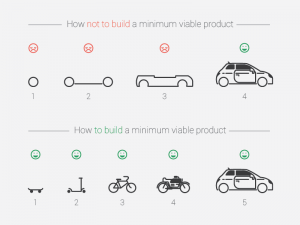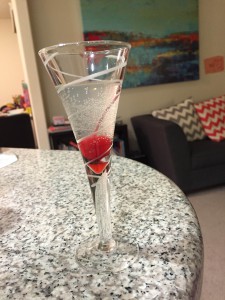I came across this cute, but powerful, image on the evolution of an MVP. Not every great product happens like this, even if it’s done via a minimum viable product, but still, this is a powerful image.  I tried to figure out where this image came from to link back to it, but couldn’t.
I tried to figure out where this image came from to link back to it, but couldn’t.
Author: healyjones
Lazy gin fizz
StandardContinuing with my theme of simple gin drinks (see the lazy aviation recipe here), I use San Pellegrino sodas, gin and bitters to make a simple, sweet citrus drink.
Lazy Gin Fizz recipe
2 ounces gin
4 ounces San Pellegrino Limonata or Aranciata Rossa soda
2 drops Angostura Orange Bitters
Pour the gin and San Pellegrino soda into a glass with ice. Drop in the bitters. Stir and enjoy!
Cioppino recipe I made for Christmas Eve
StandardI’ve made cioppino, a San Francisco favorite, for a few Christmas Eve’s recently. Cioppino is a seafood stew with a tomato base, and usually has a white fish (in this case halibut), some shellfish and crab. It’s hearty, warm and, other than all the chopping, pretty easy to make. Plus, it pairs well with a light red wine like a pinot noir, so it’s perfect for the holidays.
It’s pronounced “cho pinot” and I can never spell it!
I’ve adapted this recipe after experimenting with it several times. The novel ingredient, at least in my mind, is the fennel. It’s not something that I cook with usually, and has a strong smell/flavor that really blends into the stew in a way that I wouldn’t expect.
Here is the cioppino recipe:
Cioppino (seafood stew) recipe
As much butter and olive oil as you want – maybe 2 tbsp of butter and 2 tbsp olive oil
1 medium-sized yellow onion, chopped (see below for how big for all chopped ingredients)
2 medium-sized carrots, peeled & chopped
1 celery stalk, chopped
1 green bell pepper, chopped
2 small shallots, chopped (you can use 1 leek instead, but I had shallots)
1⁄2 small fennel bulb, chopped (also called star anise in some grocery stores, although trying to read about the difference between star anise and fennel gets pretty confusing)
2 28-oz. cans/boxes crushed Italian tomatoes
4 tbsp. tomato paste
2 bay leaves
1 tsp. dried oregano (I used 3 tsp of fresh)
1 tsp. dried thyme
1 tsp. dried basil (I used 3 tsp of fresh)
2 pinches cayenne (I did not put this in because my kid can’t handle it, but I recommend it)
Salt and freshly ground black pepper
1 cup red wine, I used a pinot (make sure the red wine goes with fish! I try the wine with a shrimp before adding to make sure it doesn’t give off a fishy/metallic taste with the fish).
1 can fish stock or clam juice or clam stock (make sure you don’t use asian fish sauce, which is pretty different. And if you have to, you can use chicken or vegetable stock, but I highly recommend a seafood stock)
2 cloves garlic, finely chopped
3/4 lbs. halibut filet, cut into 3/4 inch or 1 inch pieces
1/4 lbs sea scallops
1/4 large shrimp, peeled & deveined (you can also use cooked, which you’ll add later in the cooking process, just to warm)
1 lb oz. cooked crab (the crab is pretty important. You can use a tin of already done crab meat, or since I’m in the San Francisco area, I usually use Dungeness crab. This year I used King crab because the Dungeness wasn’t available). Deshell the crab into big pieces.
1/4 lbs clams or muscles
1⁄2 bunch parsley, chopped
Everything that is chopped should be just over diced in size – about 1/3 of an inch square.
In a large pot, heat the oil and the butter over medium heat. Add the onions and celery and cook, stirring often, for 2 minutes (the onions should not yet bet translucent, but should be getting softer). Add the carrots, peppers, shallots (or leek), and fennel and cook on medium heat, stirring often, for about 8 minutes. Pour in the crushed tomatoes, stir. Then add the tomato paste, bay leaves, oregano, thyme, basil, wine, fish/clam stock, and cayenne (optional) and season to taste with salt and pepper. Increase the head to bring the pot to a boil, then, stir and reduce the heat to low. Simmer the pot for 30 minutes to 2 hours (the longer the better, as the flavors will meld).
Add the clams or mussels to the cooking liquid. Cover and cook until the clams and mussels begin to open, about 5 minutes. Add the shrimp, scallops and fish. (Some cioppino recipes pan fry the shrimp, scallops and fish prior to adding to the stew, but I like to let them cook in the liquid to soak up the flavors). Simmer gently, stirring often) until the fish and shrimp are just cooked through, and the clams are completely open, add the cooked crab and cook about 5 minutes longer (discard any clams and mussels that do not open). Season the soup, to taste, with more salt and pepper.
Add pinch of chopped parsley to each bowl of cioppino, and serve with garlic bread.
So, that’s Healy Jones’ holiday cioppino recipe.
Recent LTV post by David Skok
StandardI had the pleasure of being a board observer to a company that had David Skok on the board. He is a pretty amazing operator turned VC, and his most recent post on LTV is just great.
For some reason, a lot of entrepreneurs forget to use gross margin when calculating long term value of a customer. David’s formula is pretty clear on how to use churn rate, gross margin and of course revenue to calculate LTV. Check it out!
Ogilvy on direct response advertising
VideoOgilvy, the master of direct response (DR) advertising, speaks about why data should drive advertising. I think this is pretty obvious today for online marketing, but as as larger companies work to pull in offline advertising into the online world (in particular, social) his words still ring true.
Lazy Aviation Recipe
StandardI happen to love gin drinks, and the Aviation is a favorite. Lemon, gin, maraschino liqueur, crème de violette and a maraschino cherry. Incredibly refreshing.
However, I don’t always have fresh lemons on hand, and even if I do, I can be lazy. So I’ve come up with a pretty darn good aviation recipe that uses San Pellegrino Limonata soda.
Lazy Aviation Cocktail Recipe
1 1/2 ounces gin
1 ounce San Pellegrino Limonata (lemon) soda, chilled
3/4 ounces maraschino liqueur
1/4 ounce crème de violette
1 maraschino cherry – the sweet ones you loved when you were a kid!
Pour the gin, maraschino liqueur and crème de violette into a shaker, over ice. Shake until chilled.
Add the San Pellegrino soda to the shaker, stir lightly (don’t shake, the soda will foam up like crazy and make a mess)
Drop the maraschino cherry into a martini glass. Maybe just a drop of the sweet syrup that’s in the cherry jar too…
Pour the liquor mix into the glass.
Optional: I sometimes hold back the crème de violette and pour it into the glass first, then add the other liquor on top with a slow pour. The best bartenders often layer on the liquors in their Aviation cocktails… making it look like a sunrise when you are on a plane.
There you go – an original cocktail recipe by Healy Jones.
Google, Facebook and Mobile
StandardFacebook is allowing Google to index some user profiles for mobile searches. Check out the piece on MediaPost.
Other interesting tidbit from the article:
“Facebook accounted for a 17.5% share of worldwide mobile ad spend in 2014, sliding to 17.4% in 2015, per eMarketer. Google’s worldwide mobile ad market share in 2014 was 38.4%, falling to 33.7%, a higher percentage than Facebook.”
Two great pieces that I’ve read recently
StandardI’ve come across two pieces that really resonate with my current marketing efforts.
Customer Journey Analytics
The first is on customer journey analytics – this is the first time I’ve heard this term, but considering the fact that I’m currently working with analytics as it relates to my customer’s journey, I guess it shouldn’t be!
Basically, with enough data, you can plot a customer’s journey from awareness -> consideration -> purchase -> retention -> loyalty/referring.
I’ve been mapping this journey and looking for particular instances where the metrics can be improved. It’s kind of like funnel optimization, but has a lot of interaction/touch point strategy as well as remarketing/information architecture.
This piece highlights the interaction between campaign sequencing, customer lifecycle and ad purchasing (which the author refers to as marketing timing).
Facebook Growing Ad Revenue like Crazy
This shouldn’t come as a surprise, but it’s either validating or scary to see that I’m not the only person investing in and seeing success with Facebook advertising.
Validating because I’ve tried a few times and this is the first time it’s working really well. So good for me, since I’m not failing where others are succeeding.
Scary because I wonder if this means that ad pricing will go up. I guess it’s a race between demand and additional Facebook usage?
Reusing old blog posts with traction
StandardI came across an interesting question on Growth Hackers and decided to respond – What’s the best way to clean out old blog posts?
This particular poster has a large number of blog posts that no longer apply to the company’s current business model. They get web traffic, and interest from potential customers, but the company doesn’t actually offer that product anymore.
I haven’t been in this extreme of a situation, but I have made hay from older posts and web pages in numerous web make-overs and relaunches.
The truth is that older web pages and blog posts do build up a lot of good Google juice. Both traffic and authority can develop out of older content that’s had a good run.
But things change, and so can your site’s content.
Here is how I’d approach this particular problem.
1st, I’d rank monthly traffic to the old posts in question. Below some cutoff, I’d characterize the posts into two or three segments and permanently redirect each segment to the best page from a related content perspective. As in, find the closest similar content on the site and point all of the low-traffic posts in that segment to that page.
The reason I’d do this is to preserve what you can of the link juice, while eliminating the content on the site that causes confusion for the visitors by offering a product that you just don’t sell anymore.
For the higher traffic posts, I’d find a way to rewrite the post to apply to the current business model. Unless the business had DRAMATICALLY changed, as in you used to be an uber for dog sitters and now offer marketing automation software, I think you can come up with content that is related enough to keep Google sending the traffic.
I’d approach the rewrite from a customer experience perspective. The goal is to provide something of value to the visitor. Google appreciates new content on well ranking pages, so ‘refreshing’ the content in a way that it overlaps with the visitor intent and your company’s new direction should be successful from retaining your ranking and providing a visitor experience that keeps the person engaged with the page.
A few SEO notes on the refreshed content:
- I’d keep the URL the same.
- If you can use the main keyword of the page (the former title probably) in the first or second paragraph to try to preserve some of the juice.
- The goal should be engaging content that scoots the visitor toward your current business model
Facebook advertising tips
StandardI’m finally marketing to a demo that uses Facebook, which means that there are some fun social efforts that we get to do.
I came across a really well done, in depth post, about Facebook best practices for paid ads and thought I would share it.
The summary, which I agree with, is keeping the copy short but sweet, linking to a dedicated landing page and having a lot of creative to keep your audience interested.
Below is an example for the article that works well – short copy, focused on the “you” – as in, here is what the reader can do/get out of it.
It’s a very solid article – check it out.

